IMAT 5209 - Human Factors: User Testing of Train Ticket TVM System
VerifiedAdded on 2023/06/14
|13
|1180
|161
Report
AI Summary
This report presents a usability evaluation of an Automatic Train Ticket Vending Machine (TVM), focusing on user experience, barriers to use, transaction processes, and interface design. The evaluation methodology included heuristic evaluations, cognitive walkthroughs, and feature and standards inspections. Findings revealed that users often face difficulties due to overwhelming data on screens, complex transaction journeys, unclear navigation, and a lack of familiarity with admission structures. The report concludes that the user interface of Train TVMs should be further developed, and thorough assessment through intensive client testing is necessary to improve the user experience and potentially disrupt traditional ticket purchasing methods. The report also includes a use case diagram for purchasing tickets and a bibliography of relevant research.
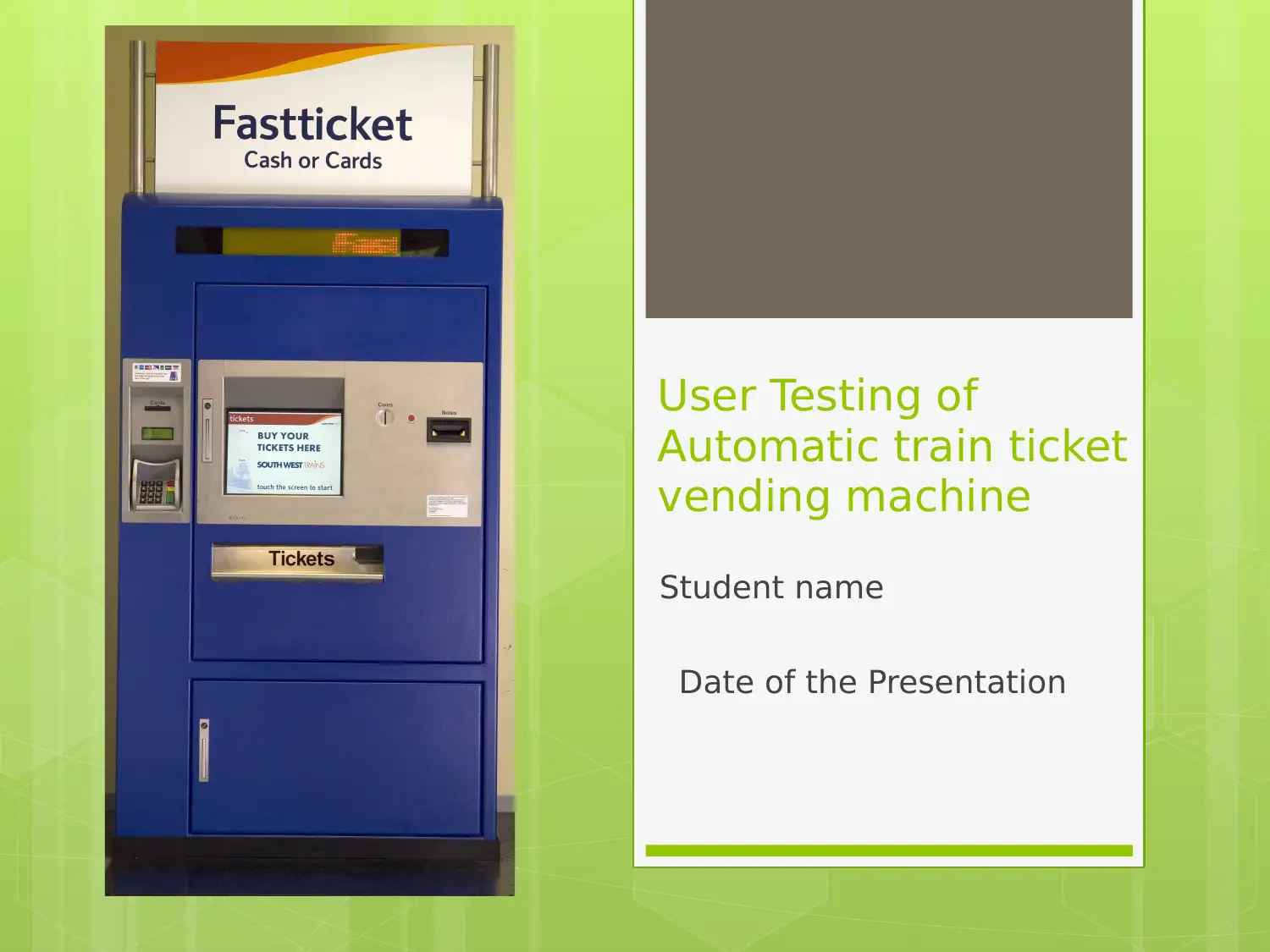
User Testing of
Automatic train ticket
vending machine
Student name
Date of the Presentation
Automatic train ticket
vending machine
Student name
Date of the Presentation
Paraphrase This Document
Need a fresh take? Get an instant paraphrase of this document with our AI Paraphraser
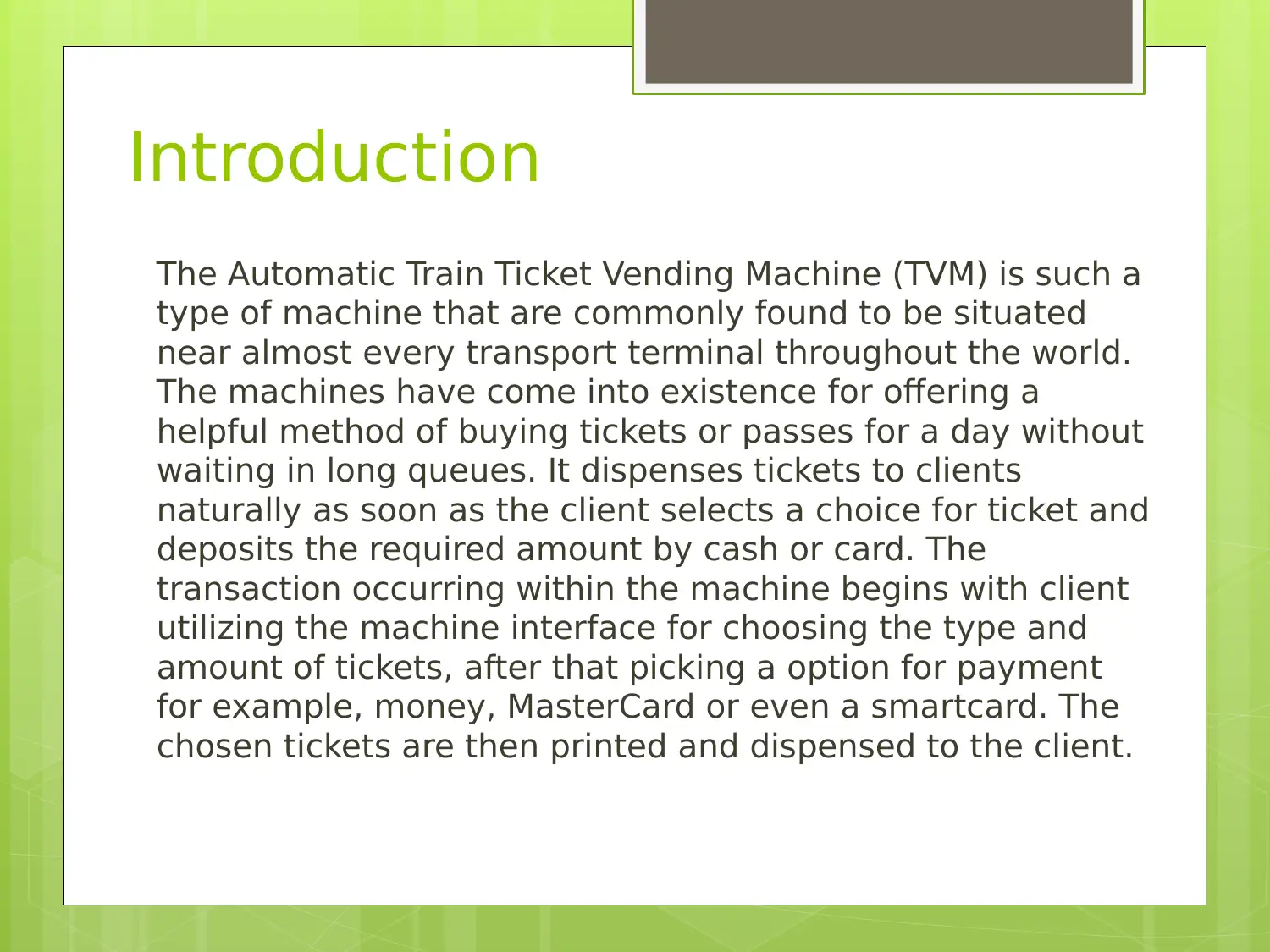
Introduction
The Automatic Train Ticket Vending Machine (TVM) is such a
type of machine that are commonly found to be situated
near almost every transport terminal throughout the world.
The machines have come into existence for offering a
helpful method of buying tickets or passes for a day without
waiting in long queues. It dispenses tickets to clients
naturally as soon as the client selects a choice for ticket and
deposits the required amount by cash or card. The
transaction occurring within the machine begins with client
utilizing the machine interface for choosing the type and
amount of tickets, after that picking a option for payment
for example, money, MasterCard or even a smartcard. The
chosen tickets are then printed and dispensed to the client.
The Automatic Train Ticket Vending Machine (TVM) is such a
type of machine that are commonly found to be situated
near almost every transport terminal throughout the world.
The machines have come into existence for offering a
helpful method of buying tickets or passes for a day without
waiting in long queues. It dispenses tickets to clients
naturally as soon as the client selects a choice for ticket and
deposits the required amount by cash or card. The
transaction occurring within the machine begins with client
utilizing the machine interface for choosing the type and
amount of tickets, after that picking a option for payment
for example, money, MasterCard or even a smartcard. The
chosen tickets are then printed and dispensed to the client.
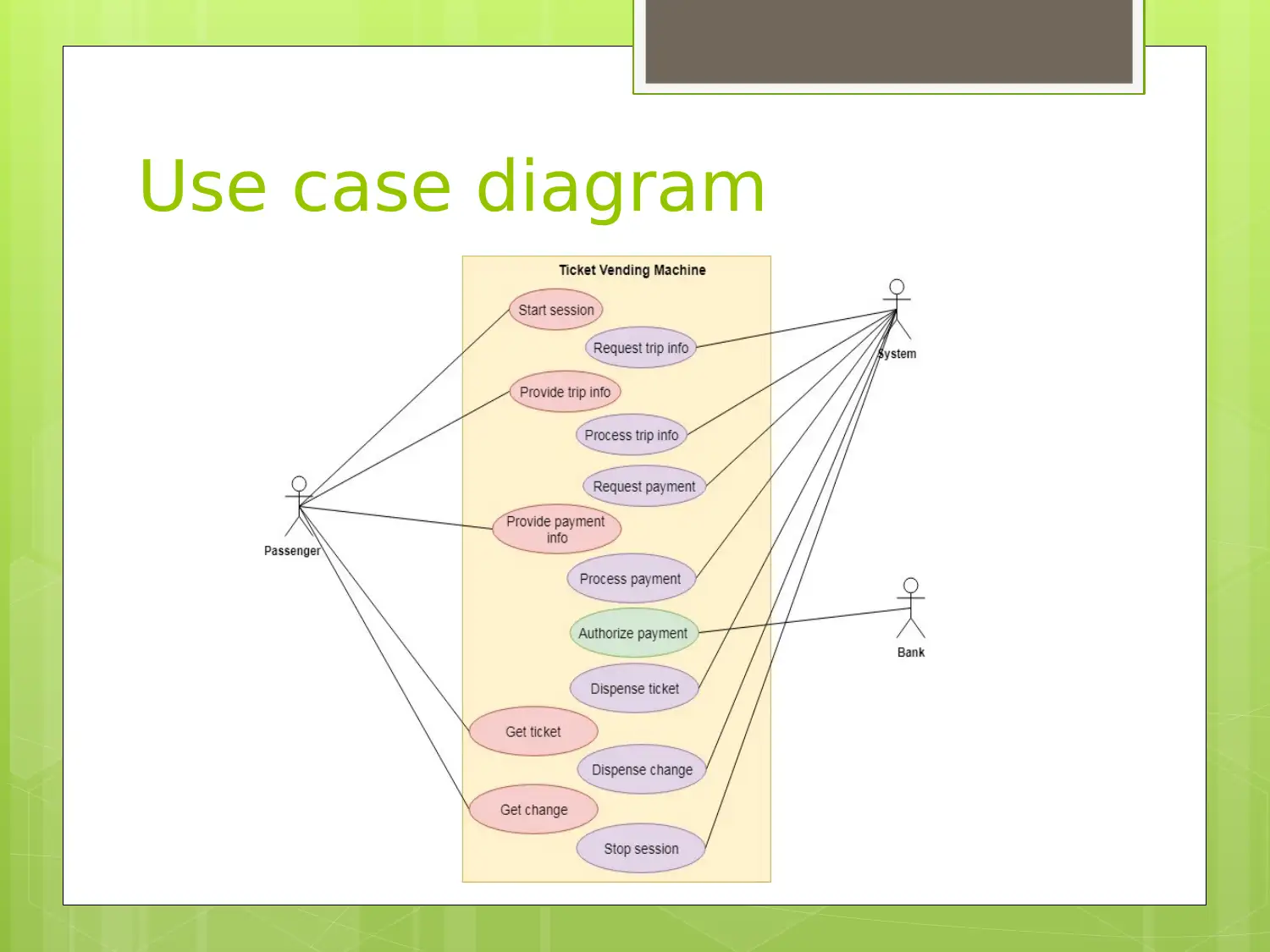
Use case diagram
⊘ This is a preview!⊘
Do you want full access?
Subscribe today to unlock all pages.

Trusted by 1+ million students worldwide
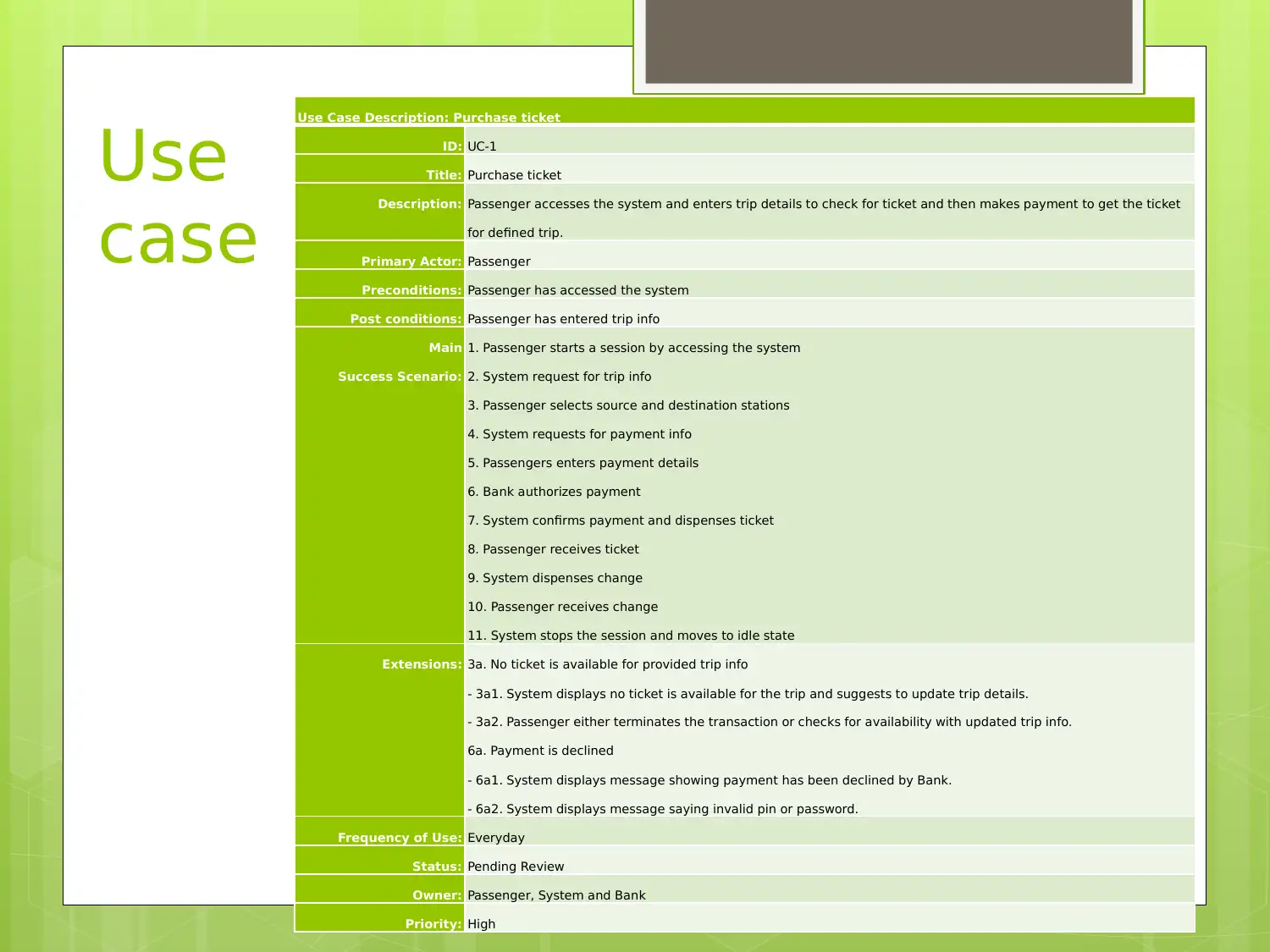
Use
case
Use Case Description: Purchase ticket
ID: UC-1
Title: Purchase ticket
Description: Passenger accesses the system and enters trip details to check for ticket and then makes payment to get the ticket
for defined trip.
Primary Actor: Passenger
Preconditions: Passenger has accessed the system
Post conditions: Passenger has entered trip info
Main
Success Scenario:
1. Passenger starts a session by accessing the system
2. System request for trip info
3. Passenger selects source and destination stations
4. System requests for payment info
5. Passengers enters payment details
6. Bank authorizes payment
7. System confirms payment and dispenses ticket
8. Passenger receives ticket
9. System dispenses change
10. Passenger receives change
11. System stops the session and moves to idle state
Extensions: 3a. No ticket is available for provided trip info
- 3a1. System displays no ticket is available for the trip and suggests to update trip details.
- 3a2. Passenger either terminates the transaction or checks for availability with updated trip info.
6a. Payment is declined
- 6a1. System displays message showing payment has been declined by Bank.
- 6a2. System displays message saying invalid pin or password.
Frequency of Use: Everyday
Status: Pending Review
Owner: Passenger, System and Bank
Priority: High
case
Use Case Description: Purchase ticket
ID: UC-1
Title: Purchase ticket
Description: Passenger accesses the system and enters trip details to check for ticket and then makes payment to get the ticket
for defined trip.
Primary Actor: Passenger
Preconditions: Passenger has accessed the system
Post conditions: Passenger has entered trip info
Main
Success Scenario:
1. Passenger starts a session by accessing the system
2. System request for trip info
3. Passenger selects source and destination stations
4. System requests for payment info
5. Passengers enters payment details
6. Bank authorizes payment
7. System confirms payment and dispenses ticket
8. Passenger receives ticket
9. System dispenses change
10. Passenger receives change
11. System stops the session and moves to idle state
Extensions: 3a. No ticket is available for provided trip info
- 3a1. System displays no ticket is available for the trip and suggests to update trip details.
- 3a2. Passenger either terminates the transaction or checks for availability with updated trip info.
6a. Payment is declined
- 6a1. System displays message showing payment has been declined by Bank.
- 6a2. System displays message saying invalid pin or password.
Frequency of Use: Everyday
Status: Pending Review
Owner: Passenger, System and Bank
Priority: High
Paraphrase This Document
Need a fresh take? Get an instant paraphrase of this document with our AI Paraphraser
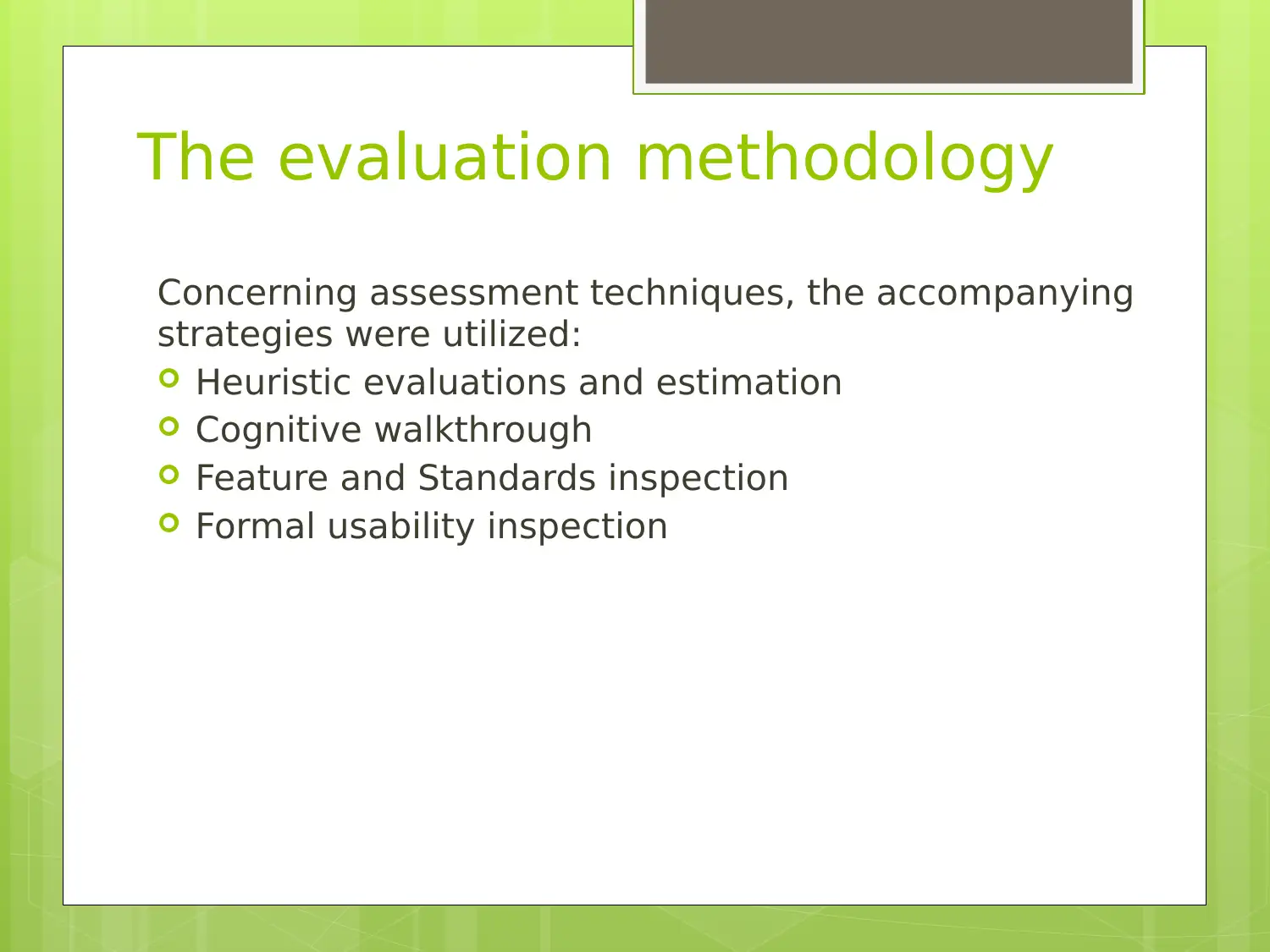
The evaluation methodology
Concerning assessment techniques, the accompanying
strategies were utilized:
Heuristic evaluations and estimation
Cognitive walkthrough
Feature and Standards inspection
Formal usability inspection
Concerning assessment techniques, the accompanying
strategies were utilized:
Heuristic evaluations and estimation
Cognitive walkthrough
Feature and Standards inspection
Formal usability inspection
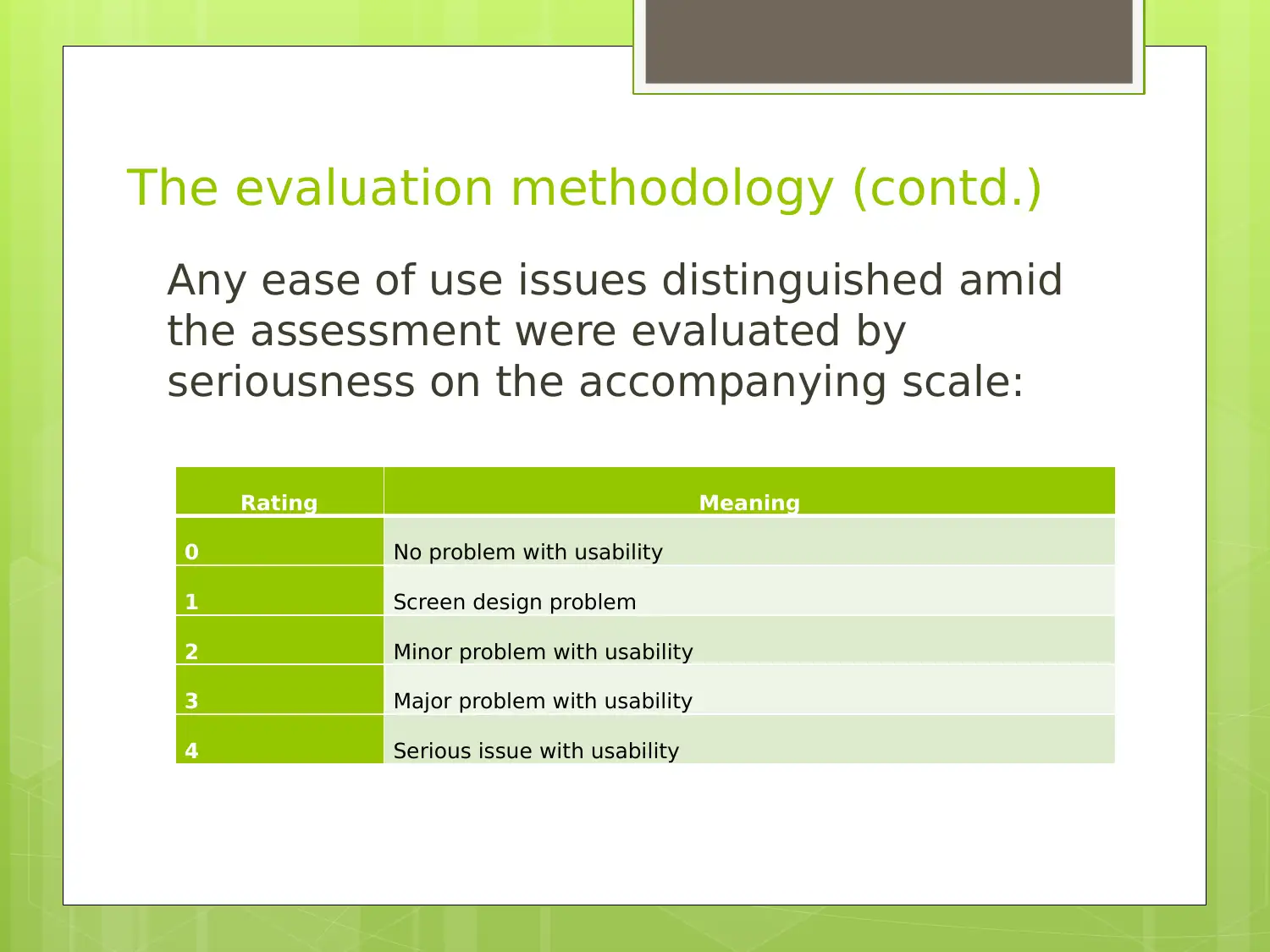
The evaluation methodology (contd.)
Any ease of use issues distinguished amid
the assessment were evaluated by
seriousness on the accompanying scale:
Rating Meaning
0 No problem with usability
1 Screen design problem
2 Minor problem with usability
3 Major problem with usability
4 Serious issue with usability
Any ease of use issues distinguished amid
the assessment were evaluated by
seriousness on the accompanying scale:
Rating Meaning
0 No problem with usability
1 Screen design problem
2 Minor problem with usability
3 Major problem with usability
4 Serious issue with usability
⊘ This is a preview!⊘
Do you want full access?
Subscribe today to unlock all pages.

Trusted by 1+ million students worldwide
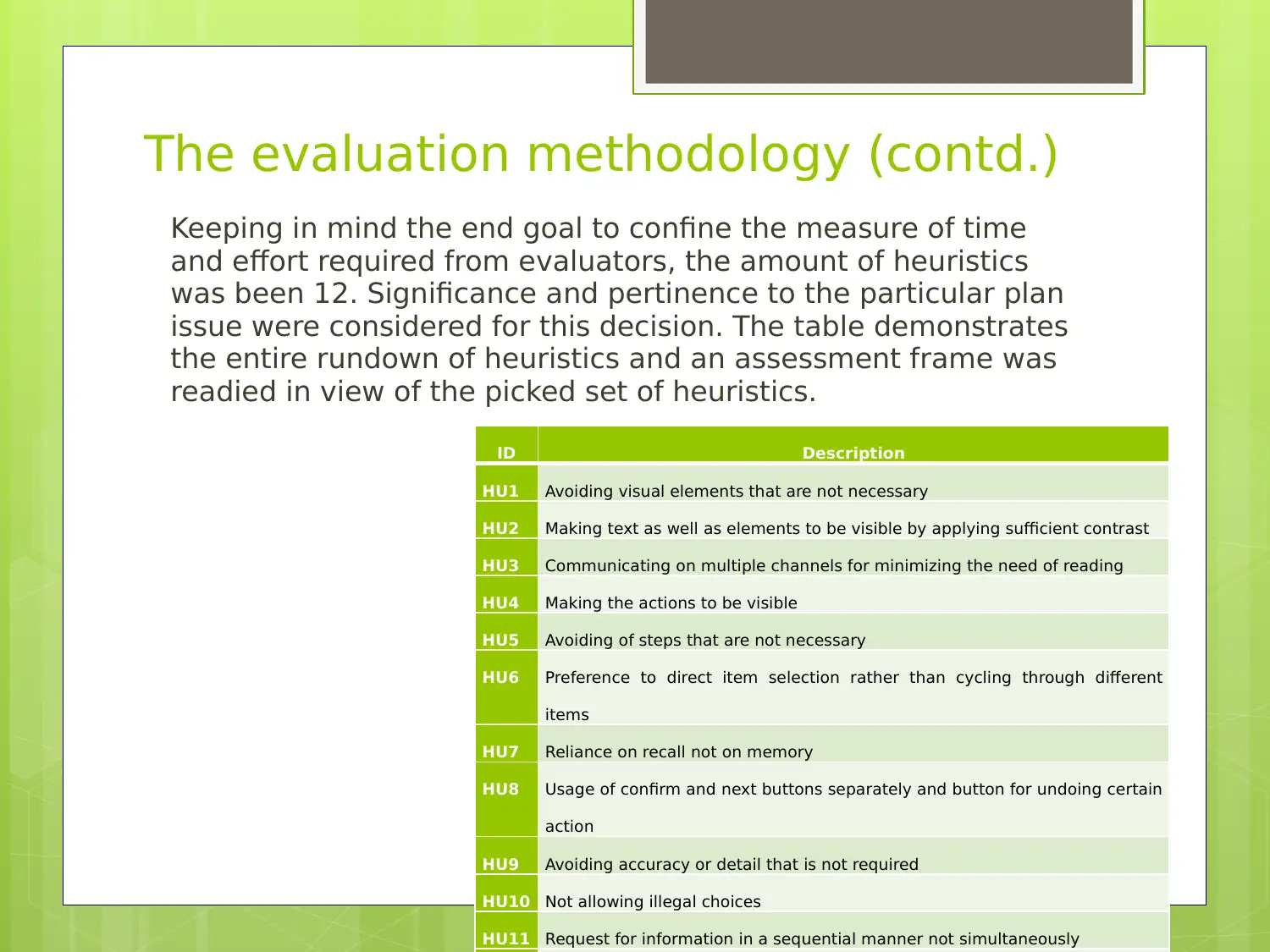
The evaluation methodology (contd.)
Keeping in mind the end goal to confine the measure of time
and effort required from evaluators, the amount of heuristics
was been 12. Significance and pertinence to the particular plan
issue were considered for this decision. The table demonstrates
the entire rundown of heuristics and an assessment frame was
readied in view of the picked set of heuristics.
ID Description
HU1 Avoiding visual elements that are not necessary
HU2 Making text as well as elements to be visible by applying sufficient contrast
HU3 Communicating on multiple channels for minimizing the need of reading
HU4 Making the actions to be visible
HU5 Avoiding of steps that are not necessary
HU6 Preference to direct item selection rather than cycling through different
items
HU7 Reliance on recall not on memory
HU8 Usage of confirm and next buttons separately and button for undoing certain
action
HU9 Avoiding accuracy or detail that is not required
HU10 Not allowing illegal choices
HU11 Request for information in a sequential manner not simultaneously
Keeping in mind the end goal to confine the measure of time
and effort required from evaluators, the amount of heuristics
was been 12. Significance and pertinence to the particular plan
issue were considered for this decision. The table demonstrates
the entire rundown of heuristics and an assessment frame was
readied in view of the picked set of heuristics.
ID Description
HU1 Avoiding visual elements that are not necessary
HU2 Making text as well as elements to be visible by applying sufficient contrast
HU3 Communicating on multiple channels for minimizing the need of reading
HU4 Making the actions to be visible
HU5 Avoiding of steps that are not necessary
HU6 Preference to direct item selection rather than cycling through different
items
HU7 Reliance on recall not on memory
HU8 Usage of confirm and next buttons separately and button for undoing certain
action
HU9 Avoiding accuracy or detail that is not required
HU10 Not allowing illegal choices
HU11 Request for information in a sequential manner not simultaneously
Paraphrase This Document
Need a fresh take? Get an instant paraphrase of this document with our AI Paraphraser
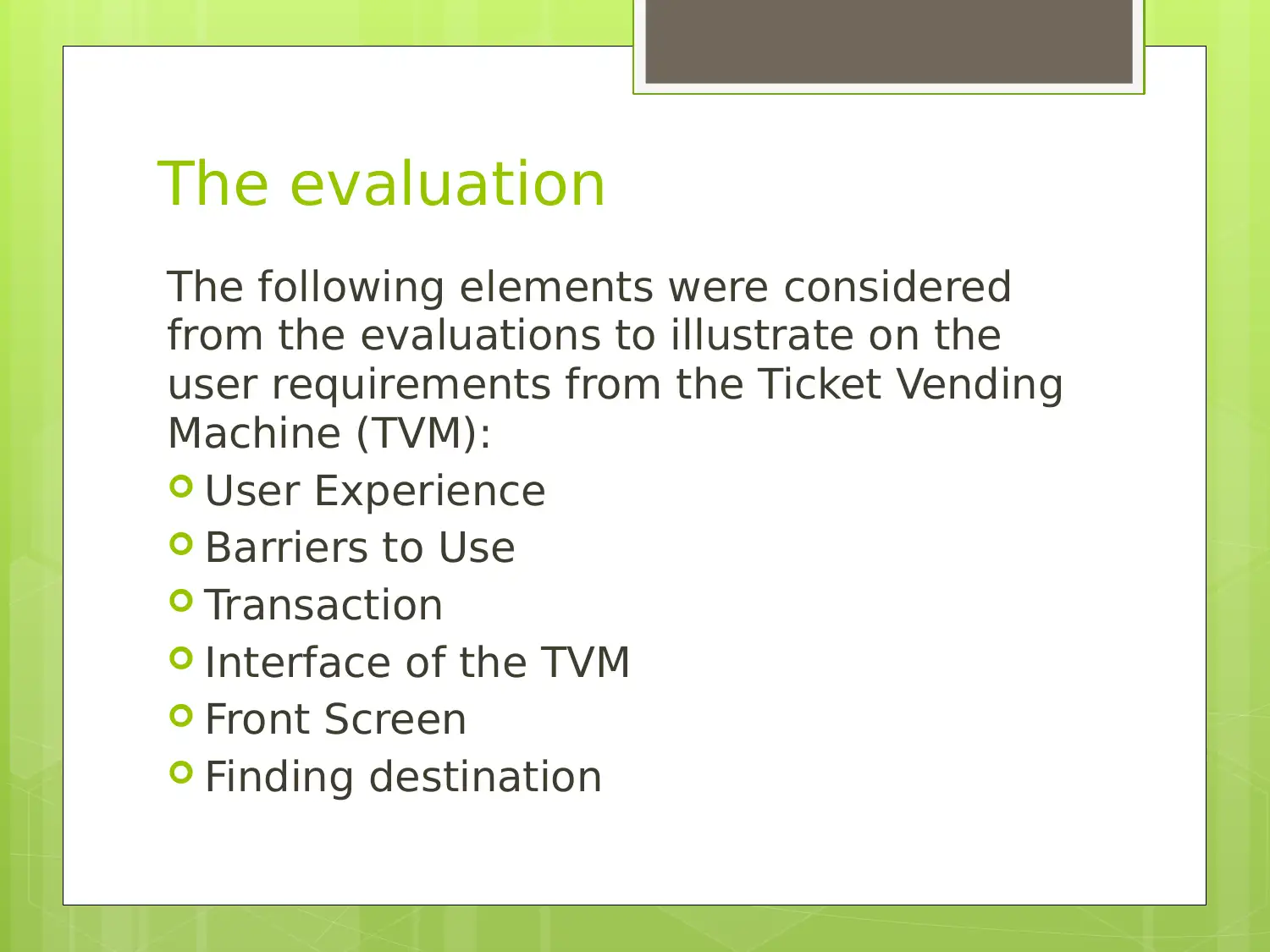
The evaluation
The following elements were considered
from the evaluations to illustrate on the
user requirements from the Ticket Vending
Machine (TVM):
User Experience
Barriers to Use
Transaction
Interface of the TVM
Front Screen
Finding destination
The following elements were considered
from the evaluations to illustrate on the
user requirements from the Ticket Vending
Machine (TVM):
User Experience
Barriers to Use
Transaction
Interface of the TVM
Front Screen
Finding destination
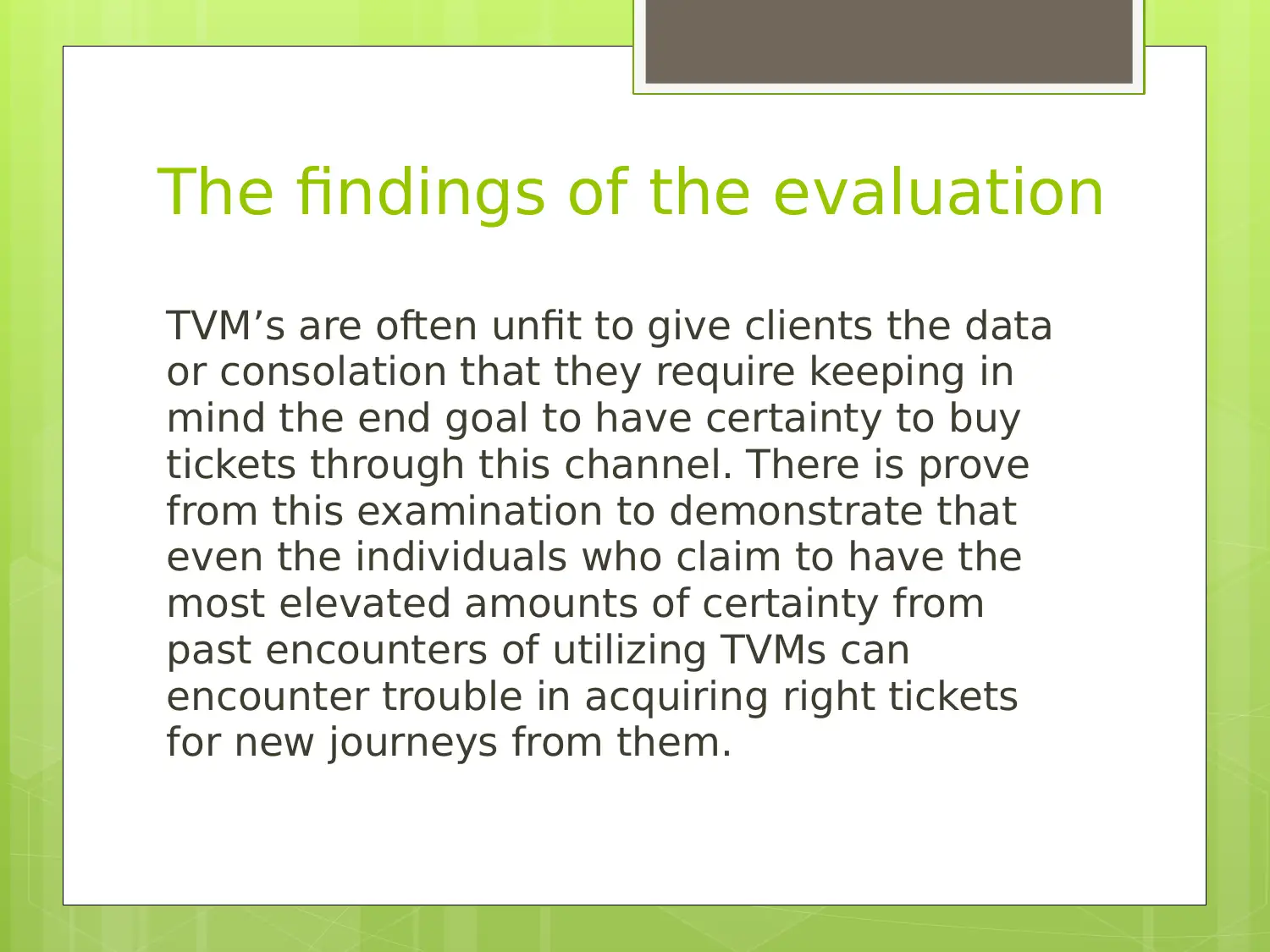
The findings of the evaluation
TVM’s are often unfit to give clients the data
or consolation that they require keeping in
mind the end goal to have certainty to buy
tickets through this channel. There is prove
from this examination to demonstrate that
even the individuals who claim to have the
most elevated amounts of certainty from
past encounters of utilizing TVMs can
encounter trouble in acquiring right tickets
for new journeys from them.
TVM’s are often unfit to give clients the data
or consolation that they require keeping in
mind the end goal to have certainty to buy
tickets through this channel. There is prove
from this examination to demonstrate that
even the individuals who claim to have the
most elevated amounts of certainty from
past encounters of utilizing TVMs can
encounter trouble in acquiring right tickets
for new journeys from them.
⊘ This is a preview!⊘
Do you want full access?
Subscribe today to unlock all pages.

Trusted by 1+ million students worldwide
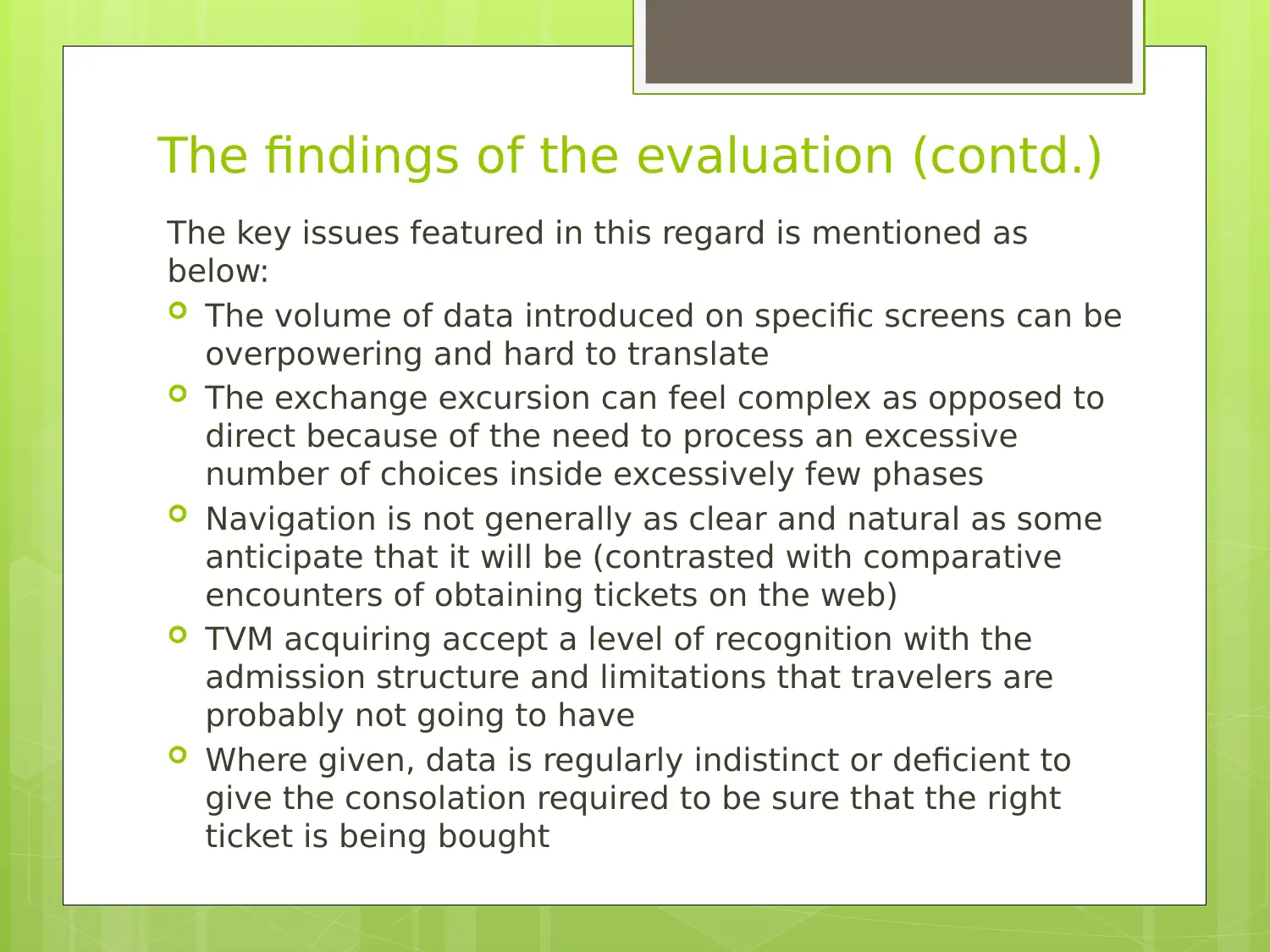
The findings of the evaluation (contd.)
The key issues featured in this regard is mentioned as
below:
The volume of data introduced on specific screens can be
overpowering and hard to translate
The exchange excursion can feel complex as opposed to
direct because of the need to process an excessive
number of choices inside excessively few phases
Navigation is not generally as clear and natural as some
anticipate that it will be (contrasted with comparative
encounters of obtaining tickets on the web)
TVM acquiring accept a level of recognition with the
admission structure and limitations that travelers are
probably not going to have
Where given, data is regularly indistinct or deficient to
give the consolation required to be sure that the right
ticket is being bought
The key issues featured in this regard is mentioned as
below:
The volume of data introduced on specific screens can be
overpowering and hard to translate
The exchange excursion can feel complex as opposed to
direct because of the need to process an excessive
number of choices inside excessively few phases
Navigation is not generally as clear and natural as some
anticipate that it will be (contrasted with comparative
encounters of obtaining tickets on the web)
TVM acquiring accept a level of recognition with the
admission structure and limitations that travelers are
probably not going to have
Where given, data is regularly indistinct or deficient to
give the consolation required to be sure that the right
ticket is being bought
Paraphrase This Document
Need a fresh take? Get an instant paraphrase of this document with our AI Paraphraser

Conclusion
In conclusion from the overall results of
evaluation, it can be at long last
prescribed that considered user interface
of Train TVMs ought to be additionally
developed in consequent models and
there is a need for thorough assessment
using intensive client testing. Besides that
if the design holds up for further
investigation, it might eventually disturb
the way tickets are purchased at the
station.
In conclusion from the overall results of
evaluation, it can be at long last
prescribed that considered user interface
of Train TVMs ought to be additionally
developed in consequent models and
there is a need for thorough assessment
using intensive client testing. Besides that
if the design holds up for further
investigation, it might eventually disturb
the way tickets are purchased at the
station.
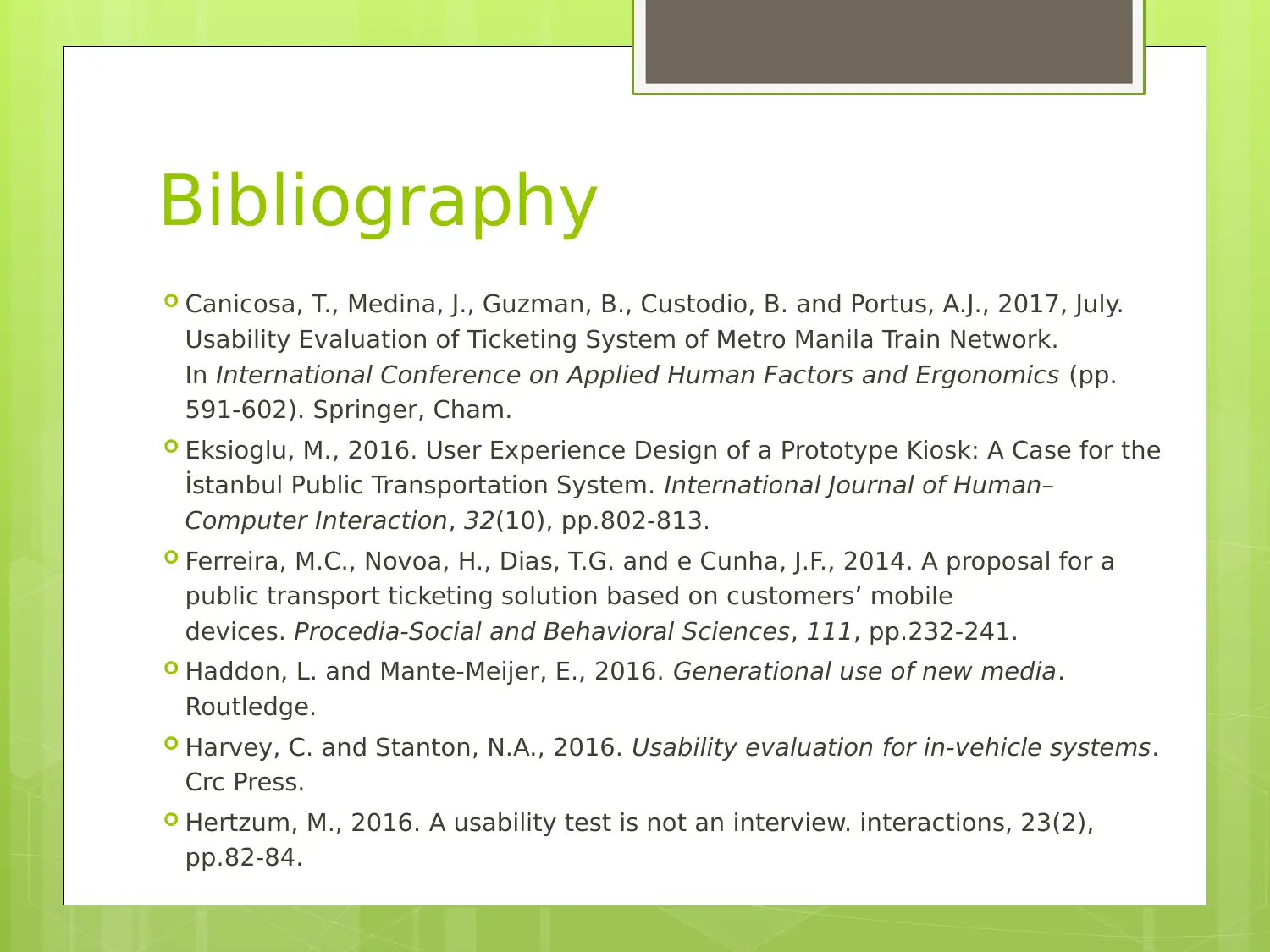
Bibliography
Canicosa, T., Medina, J., Guzman, B., Custodio, B. and Portus, A.J., 2017, July.
Usability Evaluation of Ticketing System of Metro Manila Train Network.
In International Conference on Applied Human Factors and Ergonomics (pp.
591-602). Springer, Cham.
Eksioglu, M., 2016. User Experience Design of a Prototype Kiosk: A Case for the
İstanbul Public Transportation System. International Journal of Human–
Computer Interaction, 32(10), pp.802-813.
Ferreira, M.C., Novoa, H., Dias, T.G. and e Cunha, J.F., 2014. A proposal for a
public transport ticketing solution based on customers’ mobile
devices. Procedia-Social and Behavioral Sciences, 111, pp.232-241.
Haddon, L. and Mante-Meijer, E., 2016. Generational use of new media.
Routledge.
Harvey, C. and Stanton, N.A., 2016. Usability evaluation for in-vehicle systems.
Crc Press.
Hertzum, M., 2016. A usability test is not an interview. interactions, 23(2),
pp.82-84.
Canicosa, T., Medina, J., Guzman, B., Custodio, B. and Portus, A.J., 2017, July.
Usability Evaluation of Ticketing System of Metro Manila Train Network.
In International Conference on Applied Human Factors and Ergonomics (pp.
591-602). Springer, Cham.
Eksioglu, M., 2016. User Experience Design of a Prototype Kiosk: A Case for the
İstanbul Public Transportation System. International Journal of Human–
Computer Interaction, 32(10), pp.802-813.
Ferreira, M.C., Novoa, H., Dias, T.G. and e Cunha, J.F., 2014. A proposal for a
public transport ticketing solution based on customers’ mobile
devices. Procedia-Social and Behavioral Sciences, 111, pp.232-241.
Haddon, L. and Mante-Meijer, E., 2016. Generational use of new media.
Routledge.
Harvey, C. and Stanton, N.A., 2016. Usability evaluation for in-vehicle systems.
Crc Press.
Hertzum, M., 2016. A usability test is not an interview. interactions, 23(2),
pp.82-84.
⊘ This is a preview!⊘
Do you want full access?
Subscribe today to unlock all pages.

Trusted by 1+ million students worldwide
1 out of 13
Your All-in-One AI-Powered Toolkit for Academic Success.
+13062052269
info@desklib.com
Available 24*7 on WhatsApp / Email
![[object Object]](/_next/static/media/star-bottom.7253800d.svg)
Unlock your academic potential
Copyright © 2020–2025 A2Z Services. All Rights Reserved. Developed and managed by ZUCOL.

